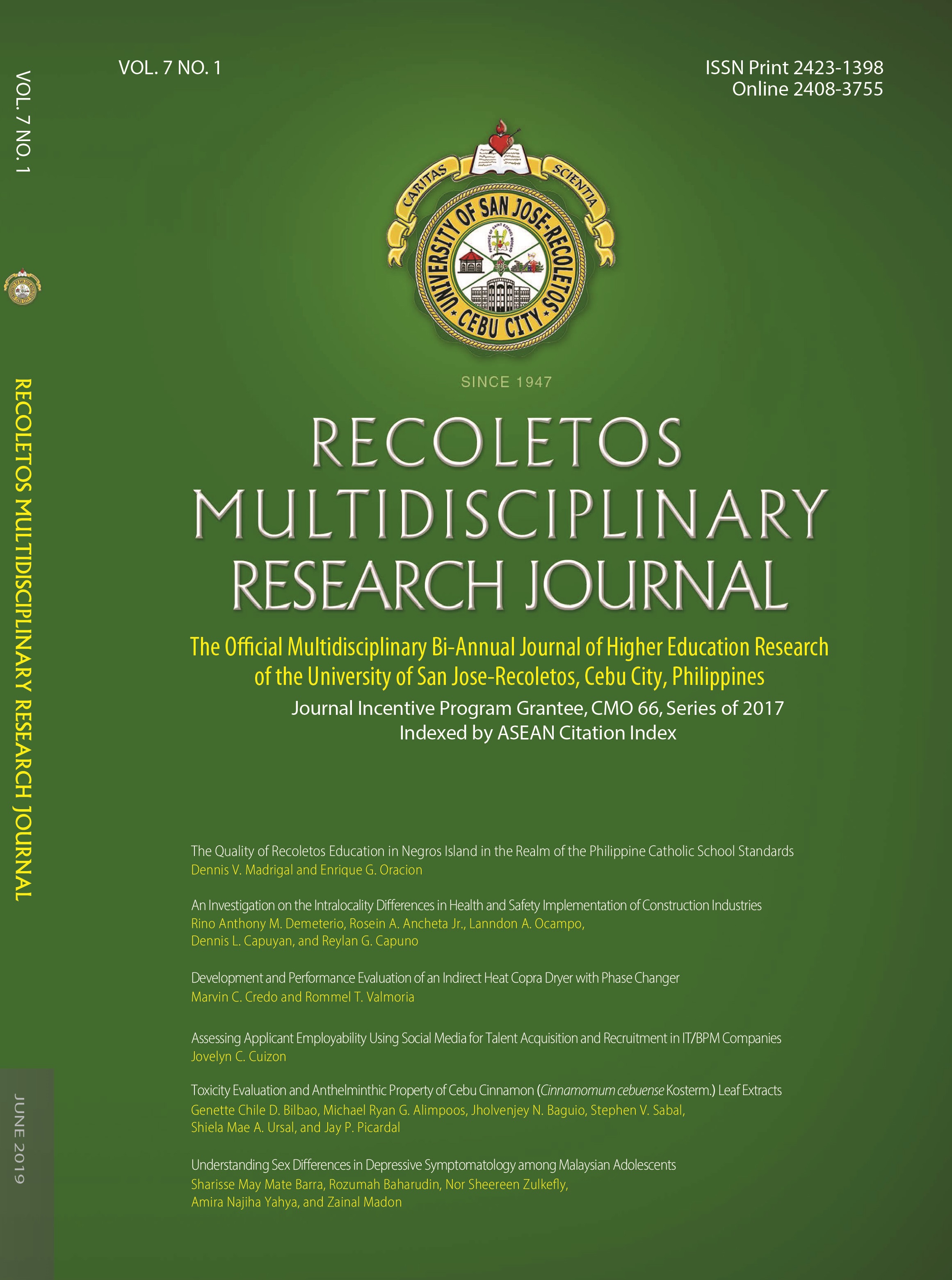Development and Performance Evaluation of an Indirect Heat Copra Dryer with Phase Changer
A Comparison with Kiln Drying and Open Sun Drying of Copra
DOI:
https://doi.org/10.32871/rmrj1907.01.03Keywords:
thermal efficiency, solar radiation, moisture content, fired dryer, copra gradingAbstract
In the Philippines, farming communities produce copra using traditional open sun drying method that could be severely affected by heavy rainfall, temperature change, and intermittent sunshine, which could cause high microbial infection to the product. On the other hand, kiln drying may avoid these circumstances. However, smoke deposits in the finished product still cause farmers to have low-quality grade copra. Keeping this in view, an indirect heat copra dryer with phase changer (IHCDPC) was designed, fabricated, and evaluated in the hopes of providing farmers an alternative approach in drying copra, which may yield to producing a high-quality grade product. The developed IHCDPC was able to reduce the moisture content in fresh coconut meat from 57.4% w.b. to about 7.2% w.b. for a drying time of twenty-five hours. The IHCDPC was found out to have a thermal efficiency of 30.87%. The copra produced were graded as 84% MGC1, 13% MGC2, and 3% MGC3.
References
investigation on a solar tunnel drier for copra
drying. Journal of Scientific and Industrial
Research, 69, 635-638.
Chua, K. ., & Chou, S. (2003). Low-cost drying
methods for developing countries. Trends in
Food Science & Technology, 14(12), 519–528
doi:10.1016/j.tifs.2003.07.003
Ivanova, D., & Andonov, K. (2001). Analytical and
experimental study of combined fruit and
vegetable dryer. Energy Conversion and
Management, 42(8), 975–983. doi:10.1016/
s0196-8904(00)00108-4
Fudholi, A., Sopian, K., Ruslan, M. H., Alghoul, M.
A., & Sulaiman, M. Y. (2010). Review of solar
dryers for agricultural and marine products.
Renewable and Sustainable Energy Reviews,
14(1), 1–30. doi:10.1016/j.rser.2009.07.032
Guarte, R. C., Mühlbauer, W., & Kellert, M. (1996).
Drying characteristics of copra and quality
of copra and coconut oil. Postharvest Biology
and Technology, 9(3), 361–372. doi:10.1016/
s0925-5214(96)00032-4
Jain, D., & Tiwari, G. N. (2003). Thermal aspects of
open sun drying of various crops. Energy, 28(1),
37–54. doi:10.1016/s0360-5442(02)00084-1
Kadam, D. M., & Samuel, D. V. K. (2006). Convective
Flat-plate Solar Heat Collector for Cauliflower
Drying. Biosystems Engineering, 93(2), 189–198.
doi:10.1016/j.biosystemseng.2005.11.012
Leon, A. M., Kumar, S., & Bhattacharya, S. (2002). A
comprehensive procedure for performance
evaluation of solar food dryers. Renewable
and Sustainable Energy Reviews, 6(4), 367–393.
doi:10.1016/s1364-0321(02)00005-9
Madhiyanon, T., Phila, A., & Soponronnarit, S.
(2009). Models of fluidized bed drying
for thin-layer chopped coconut. Applied
Thermal Engineering, 29(14-15), 2849–2854.
doi:10.1016/j.applthermaleng.2009.02.003
Mohanraj, M., & Chandrasekar, P. (2008). Drying
of copra in a forced convection solar drier.
Biosystems Engineering, 99(4), 604–607.
doi:10.1016/j.biosystemseng.2007.12.004
Thanaraj, T., Dharmasena, N. D. A., & Samarajeewa,
U. (2007). Comparison of drying behaviour,
quality and yield of copra processed in either
a solar hybrid dryer on in an improved copra
kiln. International Journal of Food Science
& Technology, 42(2), 125–132. doi:10.1111/
j.1365-2621.2006.01087.x
Thanaraj, T., Dharmasena, N. D. A., & Samarajeewa,
U. (2004). Development of a rotary solar
hybrid dryer. Tropical Agriculture Research, 16,
305-315.
Singh, S., Singh, P. P., & Dhaliwal, S. (2004). Multi-shelf
portable solar dryer. Renewable Energy, 29(5),
753–765. doi:10.1016/j.renene.2003.09.010
Singh, S., & Kumar, S. (2012). New approach for
thermal testing of solar dryer: Development
of generalized drying characteristic curve.
Solar Energy, 86(7), 1981–1991. doi:10.1016/j.
solener.2012.04.001
Shanmugam, V., & Natarajan, E. (2006). Experimental
investigation of forced convection and
desiccant integrated solar dryer. Renewable
Energy, 31(8), 1239–1251. doi:10.1016/j.
renene.2005.05.019
Swain, S. (2013). Performance Evaluation of Biomass
Fired Dryer for Copra Drying: A Comparison
with Traditional Drying in Subtropical Climate.
Journal of Food Processing & Technology,
05(01). doi:10.4172/2157-7110.1000294
Thiruchelvam T; Nimal D A D; Upali S (2007).
Comparison of quality and yield of copra
processed in CRI improved kiln drying and
sun drying. Journal of Food Engineering, 78,
1446–1451.
Tyagi, V. V., Pandey, A. K., Kaushik, S. C., & Tyagi, S.
K. (2011). Thermal performance evaluation
of a solar air heater with and without
thermal energy storage. Journal of Thermal
Analysis and Calorimetry, 107(3), 1345–1352.
doi:10.1007/s10973-011-1617-3
Downloads
Published
How to Cite
Issue
Section
License
Copyright of the Journal belongs to the University of San Jose-Recoletos


